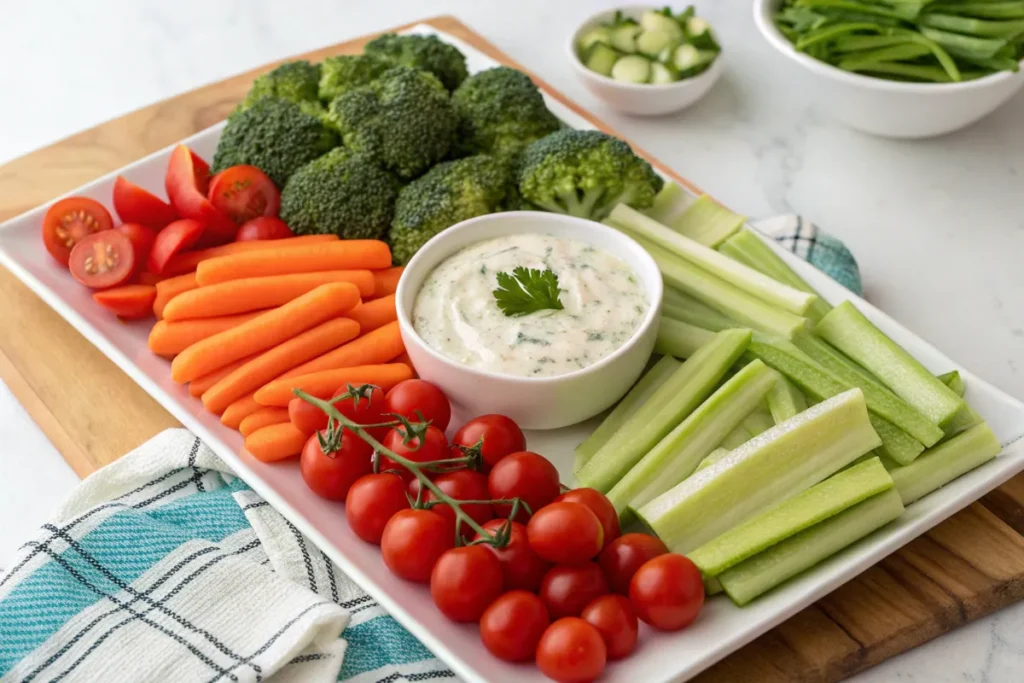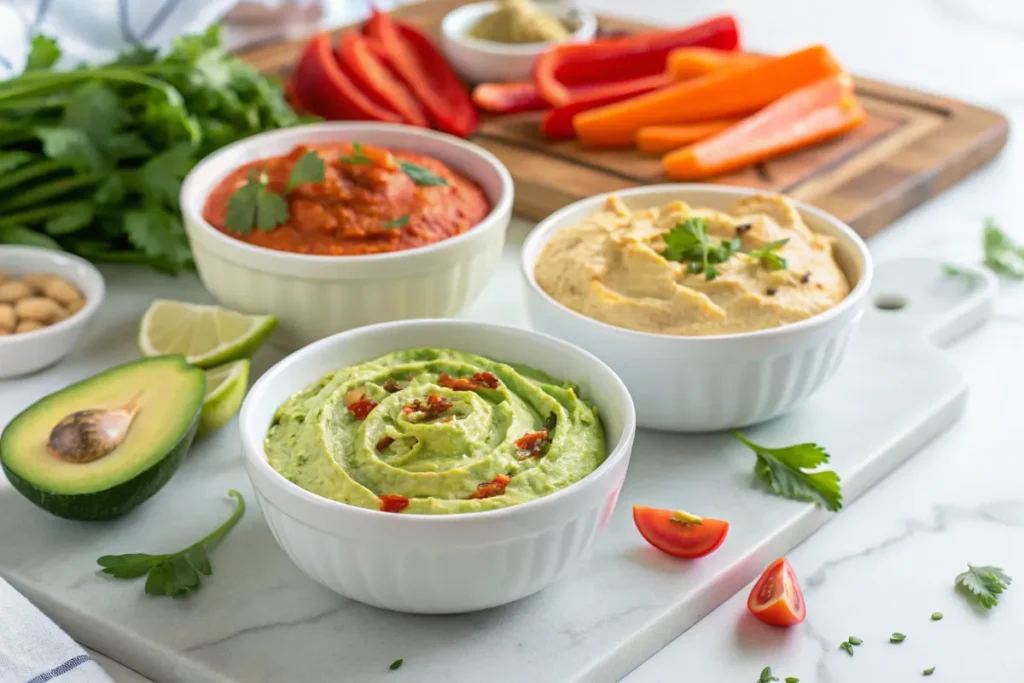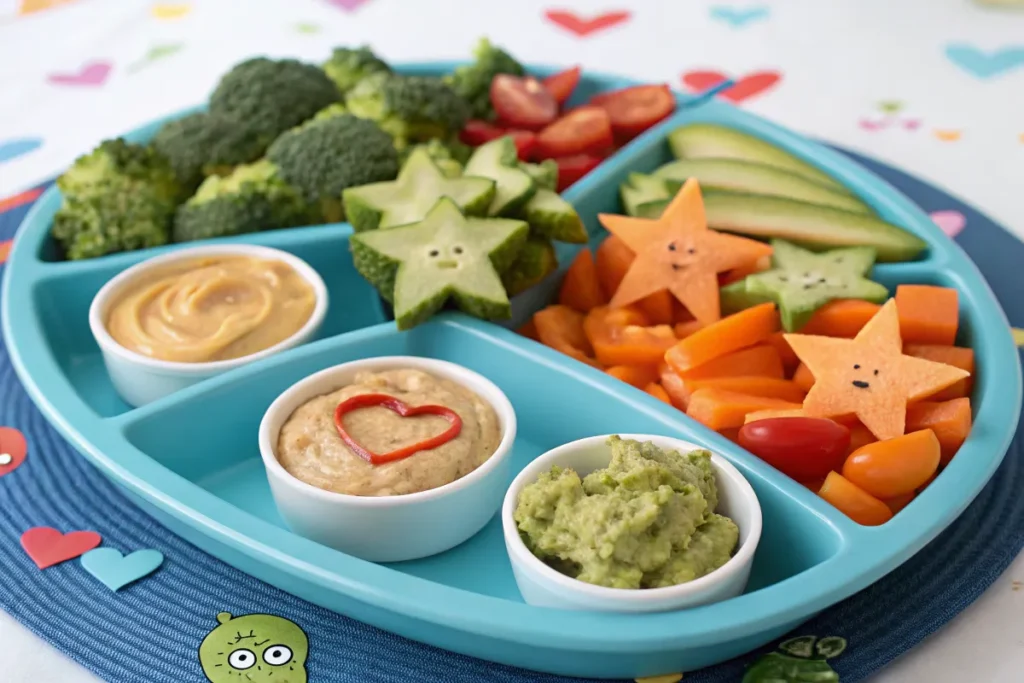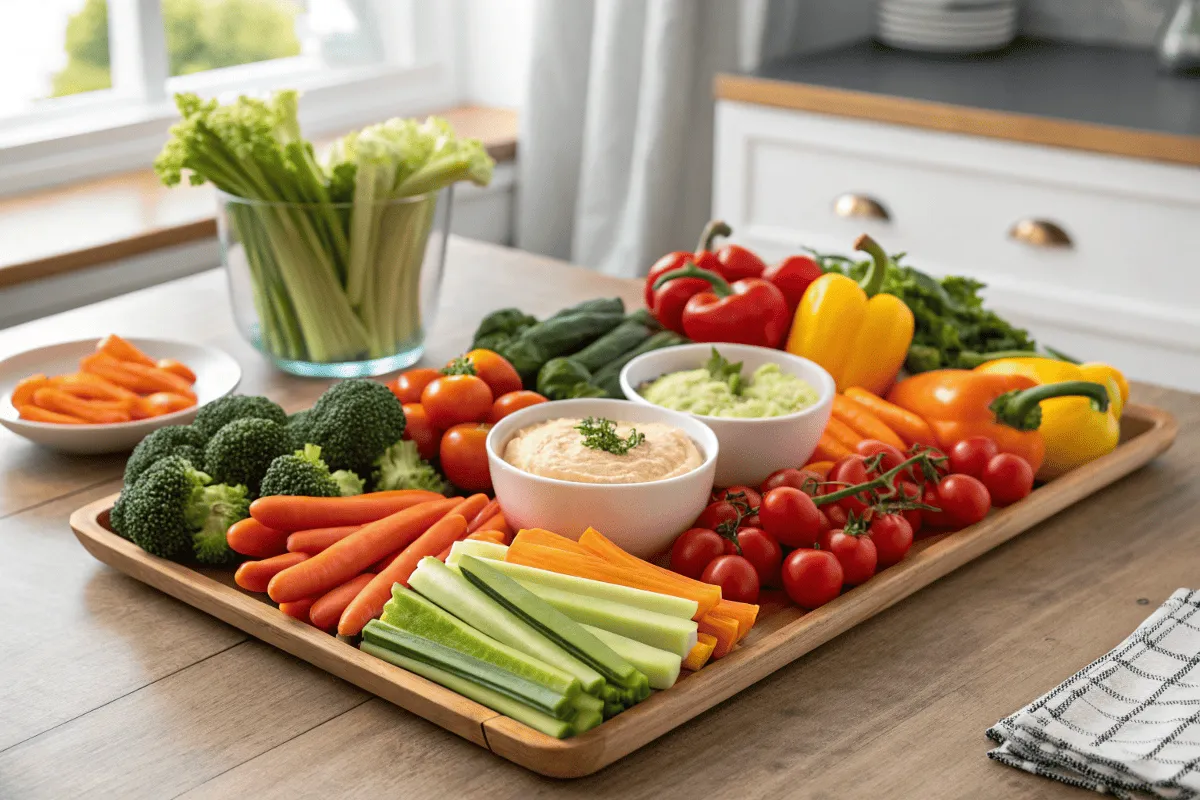Introduction to Veggie Trays
Have you ever wondered if those colorful veggie trays at parties and grocery stores are truly healthy? You’re not alone! Veggie trays, or crudités, are often hailed as a go-to snack for health-conscious individuals—but are veggie trays healthy in reality? But are they as wholesome as they seem, or do hidden pitfalls lurk beneath those neatly arranged carrots and celery sticks? Let’s dive deep into the world of veggie trays and uncover the truth about their health benefits, drawbacks, and how you can make the most of them.
Table of Contents
What Are Veggie Trays?

Veggie trays are a beautifully arranged selection of raw or lightly blanched vegetables, typically served with a dip. They are a staple at parties, family gatherings, and even in office lunches. Think of them as the MVP of appetizers—versatile, easy to prepare, and full of color. The classic combo often includes carrots, celery, broccoli, and cherry tomatoes. Some trays come with extras like bell peppers, cucumbers, or radishes.
A Brief History of Veggie Trays
Surprisingly, veggie trays date back to the early 20th century when raw vegetables became a trendy hors d’oeuvre. This shift mirrored an increased interest in health and wellness during that era. Over the decades, veggie trays evolved, becoming a symbol of clean eating and a staple in the diet of health-conscious individuals.
Why Are Veggie Trays Popular for Gatherings?
Veggie trays have universal appeal—they cater to various dietary preferences, are easy to share, and add a splash of color to any table. They also carry an air of healthiness, making hosts feel good about offering them. Plus, who doesn’t love a crunchy carrot stick dipped in creamy hummus?
Nutritional Value of Veggie Trays
You might be wondering, “Okay, they’re convenient, but are veggie trays healthy enough to eat every day?”The answer lies in the nutritional value of the veggies and dips.
Common Vegetables Found in Veggie Trays and Their Benefits
Each vegetable in a tray brings its own set of nutrients to the table. Let’s break it down:
Carrots: A Crunchy Powerhouse
Carrots are loaded with beta-carotene, which your body converts into vitamin A. This vitamin is essential for good vision, immune health, and glowing skin. Plus, they’re naturally sweet, making them a favorite even among kids.
Celery: Low-Calorie Hydration Booster
Celery is almost like water in a crunchy form! It’s low in calories but high in hydration and fiber. It’s great for digestion and can even act as a palate cleanser between different dips.
Broccoli and Cauliflower: Cruciferous Gems
These veggies are part of the cruciferous family, known for their cancer-fighting properties. They’re packed with vitamin C, fiber, and antioxidants that help combat inflammation and support overall health.
Dips and Their Impact on Health
Ah, the dips—a crucial part of any veggie tray. But not all dips are created equal. Some can be sneaky calorie bombs!
Popular Dips: Ranch, Hummus, and More
Ranch dressing is a crowd favorite but can pack a punch in calories and unhealthy fats. A smarter swap might be dips made from Greek yogurt—try variations similar to those in our Ninja Creami Frozen Yogurt Recipes.
On the other hand, hummus, made from chickpeas, offers a healthier alternative with fiber and protein.
Healthier Dip Alternatives to Consider

Swap out ranch for Greek yogurt-based dips or guacamole. These alternatives provide good fats, fewer calories, and a creamy texture that complements the veggies perfectly.
“Your choice of dip can make or break the health factor of a veggie tray. Choose wisely to maximize benefits.”
Health Benefits of Veggie Trays
Now, let’s focus on the good stuff—the undeniable health perks of munching on a veggie tray.
Contribution to Daily Fiber Intake
Fiber is essential for digestion, and most of us don’t get enough. A veggie tray is an easy way to sneak in some extra fiber, helping with everything from maintaining a healthy weight to lowering cholesterol levels.
Vitamins and Minerals in Veggie Trays
Each bite of a veggie tray is like a mini multivitamin. Carrots for vitamin A, broccoli for vitamin C, and celery for potassium—you’re getting a mix of essential nutrients without even realizing it.
Aiding Weight Management and Portion Control
Veggie trays are low in calories and high in volume, making them a great snack for weight management. The crunchiness also slows you down, allowing your brain to catch up with your stomach and signal when you’re full.
“Think of veggie trays as nature’s way of helping you snack smarter. They’re crunchy, filling, and guilt-free!”
Boosting Antioxidant Intake
Brightly colored veggies like peppers and cherry tomatoes are packed with antioxidants, which fight free radicals in your body. This can help reduce the risk of chronic diseases and even slow down aging.
Common Problems with Veggie Trays
Veggie trays might seem like a perfect snack, but they’re not without their flaws. Let’s explore some common issues people face when relying on these colorful trays as a healthy snack option.
Hidden Calories in Dips and Dressings
While the veggies themselves are low in calories, the dips can often tip the scales in the other direction. Ranch dressing, for instance, can contain up to 140 calories per two-tablespoon serving. If you’re not mindful, those “healthy” snacks can rival the calorie count of less nutritious options like chips.
Another issue? Some store-bought dips include added sugars and preservatives, which don’t do your health any favors. Imagine dipping a vitamin-packed carrot into a dip loaded with empty calories—it kind of defeats the purpose, doesn’t it?
Overuse of Pre-Packaged, Non-Organic Vegetables
Many pre-packaged veggie trays use conventionally grown produce, which may contain pesticide residues. While washing vegetables helps, it doesn’t eliminate all traces of chemicals. Additionally, pre-packaged trays often prioritize convenience over freshness, meaning the vegetables may not be as nutrient-dense as freshly prepared options.
“Freshness matters! Opting for organic or locally grown produce can make your veggie tray much healthier.”
Limited Variety in Some Trays
Let’s face it—some veggie trays are downright boring. They stick to the basics: carrots, celery, and maybe some broccoli. While these veggies are nutritious, eating the same ones repeatedly can feel uninspiring. This lack of variety also means you’re missing out on the broader range of nutrients other vegetables can provide.
Solutions to Improve the Health Factor of Veggie Trays
The good news is that with a few simple tweaks, you can transform a veggie tray into a true nutritional powerhouse.
Choosing Organic and Locally Sourced Produce
One of the easiest ways to enhance the health factor of your veggie tray is to choose organic vegetables. Organic produce is grown without synthetic pesticides or fertilizers, making it a cleaner choice. Local produce is another great option—it’s fresher, more nutrient-dense, and supports local farmers.
💡 Quick Tip: Visit your local farmer’s market for seasonal vegetables to add to your tray. Seasonal veggies are often more flavorful and nutrient-packed!
Preparing Homemade Dips with Healthier Ingredients
Instead of relying on store-bought dips, try making your own. Greek yogurt can serve as a creamy base for herb-infused dips, while avocados are perfect for making guacamole. You can also experiment with hummus variations, like roasted red pepper or garlic.
Why make your own dips?
- You control the ingredients.
- No preservatives or artificial flavors.
- You can adjust the flavors to suit your taste.
“A homemade dip isn’t just healthier—it’s also an opportunity to show off your creativity in the kitchen.”
Adding a Wider Variety of Vegetables
Ditch the boring basics and experiment with less common options. Think sugar snap peas, rainbow carrots, radishes, or even roasted sweet potato slices. Not only do these options add visual appeal, but they also broaden the range of nutrients you’re consuming.
Are Veggie Trays Healthy or Just Convenient?
Let’s tackle the big question: Are pre-packaged veggie trays from grocery stores a healthy choice? This brings us right back to the question: Are veggie trays healthy, or just marketed that way? Or would it be more budget-friendly to assemble one yourself?
Pros and Cons of Pre-Packaged Veggie Trays
Store-bought trays offer undeniable convenience. They save time, require no prep work, and are ready to eat straight out of the packaging. But there’s a trade-off:
Pros:
- Time-saving
- Perfect for last-minute gatherings
- Often come with pre-portioned dips
Cons:
- Reduced freshness
- Higher cost compared to DIY trays
- Sometimes contain preservatives to extend shelf life
How to Evaluate Store-Bought Veggie Trays for Nutrition
If you’re buying a pre-packaged tray, here’s what to look for:
- Check the ingredients on the dip. Avoid options with long lists of unpronounceable additives.
- Inspect the vegetables. Bright, crisp veggies are a sign of freshness.
- Mind the packaging. Some trays use excessive plastic, which isn’t environmentally friendly.
😎 Pro Tip: If you’re in a pinch and can’t prepare a tray yourself, pair a store-bought one with a homemade dip to balance out its shortcomings.
DIY Veggie Trays: A Healthier Alternative
Making your own veggie tray isn’t just a healthier option—it’s also a fun way to get creative and tailor the tray to your preferences. If you’ve ever wondered are veggie trays healthy, making them at home gives you full control over ingredients and freshness. Plus, it’s surprisingly simple and cost-effective!
Step-by-Step Guide to Creating Your Own Veggie Tray
- Choose Fresh, Vibrant Vegetables: Head to your local farmer’s market or grocery store and pick a mix of colors and textures. Think carrots, cucumbers, bell peppers, cherry tomatoes, radishes, sugar snap peas, and broccoli.
- Wash and Prep: Thoroughly wash all vegetables to remove dirt or pesticides. Slice them into bite-sized pieces for easy snacking.
- Blanch if Needed: For veggies like broccoli and cauliflower, blanching can enhance their texture and color. Just a quick dip in boiling water, followed by an ice bath, does the trick.
- Select Your Dips: Opt for healthier options like hummus, guacamole, or a Greek yogurt-based dip. Make them from scratch for the best results!
- Arrange Creatively: Use a platter or tray with sections to keep veggies organized. Arrange them in concentric circles or by color for an Instagram-worthy presentation.
“Homemade veggie trays allow you to customize everything—from the veggies to the dips. It’s healthy eating, your way!”
Customizing for Dietary Needs: Vegan, Gluten-Free, and More
Making a DIY veggie tray gives you the flexibility to cater to specific dietary preferences. Need it vegan? Ditch the dairy-based dips and stick to plant-based options like hummus or nut-based spreads. For gluten-free guests, double-check that dips and crackers don’t include wheat ingredients.
💡 Pro Tip: Add extras like olives, roasted chickpeas, or nuts to make the tray more filling and diverse.
Veggie Trays for Different Occasions
A veggie tray isn’t just a snack—it’s an experience. Let’s explore how to tailor your tray to different settings and audiences.
Veggie Trays for Kids: Making Them Fun and Nutritious

Getting kids to eat their veggies can be a challenge, but a well-crafted veggie tray might just do the trick.
- Use Fun Shapes: Cut veggies into stars, hearts, or other playful shapes using cookie cutters.
- Offer Kid-Friendly Dips: Pair the veggies with fun dips like peanut butter, ranch, or a mild guacamole.
- Add a Pop of Color: Include vibrant vegetables like cherry tomatoes, orange peppers, and purple carrots to grab their attention.
Elegant Veggie Trays for Parties and Gatherings
For formal events, elevate your veggie tray with a touch of sophistication.
- Add Gourmet Touches: Include roasted or marinated veggies like asparagus or artichokes.
- Incorporate Cheese and Nuts: Pair veggies with gourmet cheeses or roasted nuts for a luxe feel.
- Use Stylish Platters: A wooden charcuterie board or tiered tray can transform a simple veggie platter into a centerpiece.
Travel-Friendly Veggie Tray Ideas
Need a veggie tray on the go?
- Choose Compact Vegetables: Stick to smaller, less messy options like baby carrots, celery sticks, and cherry tomatoes.
- Pre-Pack Individual Portions: Use small containers to pack single servings of veggies and dips.
- Opt for Sturdy Dips: Avoid runny dips like thin dressings that could spill during transport.
😋 Pro Tip: Pack a veggie tray for road trips or picnics—it’s a refreshing alternative to processed snacks!
Frequently Asked Questions About Veggie Trays
Let’s tackle some common questions that come up when talking about veggie trays.
How Long Do Veggie Trays Last?
A freshly made veggie tray can last up to 3-4 days in the refrigerator if stored properly. Keep the vegetables in airtight containers and store dips separately to maintain freshness.
Can Veggie Trays Be Frozen?
Technically, some vegetables can be frozen, but it’s not recommended for veggie trays. Freezing can change the texture of raw veggies, making them less appealing for snacking.
“Freshness is key! Prep small batches to ensure your veggie tray stays crisp and vibrant.”
What Are Some Unique Veggies to Include?
Spice up your veggie tray by including less common options like:
- Jicama: A crunchy, slightly sweet root vegetable.
- Watermelon Radish: Adds a burst of color and mild spiciness.
- Romanesco: A striking, fractal-shaped vegetable that’s both nutritious and eye-catching.
Conclusion: Are Veggie Trays Worth It for Your Health?
Absolutely! Veggie trays are a versatile, nutritious, and easy way to boost your veggie intake. Whether you’re making one for a party, a quick snack, or even a meal substitute, they can be as healthy as you make them. By focusing on fresh, high-quality vegetables and pairing them with wholesome dips, you can enjoy all the benefits without the hidden pitfalls. So the next time you see a veggie tray at a gathering, don’t hesitate—grab a plate and dive in!

